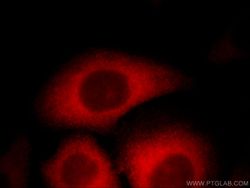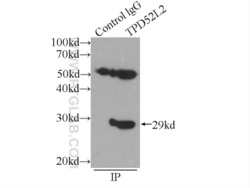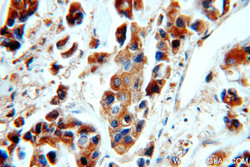Antibody data
- Antibody Data
- Antigen structure
- References [8]
- Comments [0]
- Validations
- Western blot [1]
- Immunocytochemistry [1]
- Immunoprecipitation [1]
- Immunohistochemistry [1]
Submit
Validation data
Reference
Comment
Report error
- Product number
- 11795-1-AP - Provider product page

- Provider
- Proteintech Group
- Proper citation
- Proteintech Cat#11795-1-AP, RRID:AB_2207431
- Product name
- TPD52L2 antibody
- Antibody type
- Polyclonal
- Description
- KD/KO validated TPD52L2 antibody (Cat. #11795-1-AP) is a rabbit polyclonal antibody that shows reactivity with human, mouse, rat and has been validated for the following applications: IF, IHC, IP, WB,ELISA.
- Reactivity
- Human, Mouse, Rat
- Host
- Rabbit
- Conjugate
- Unconjugated
- Isotype
- IgG
- Vial size
- 20ul, 150ul
Submitted references Investigation of Transcript Variant 6 of TPD52L2 as a Prognostic and Predictive Biomarker in Basal-Like MDA-MB-231 and MDA-MB-453 Cell Lines for Breast Cancer.
Tumor protein D54 binds intracellular nanovesicles via an extended amphipathic region.
Tumor protein D52 is upregulated in oral squamous carcinoma cells under hypoxia in a hypoxia-inducible-factor-independent manner and is involved in cell death resistance.
Silencing of TPD52 inhibits proliferation, migration, invasion but induces apoptosis of pancreatic cancer cells by deactivating Akt pathway.
TPD52L2 impacts proliferation, invasiveness and apoptosis of glioblastoma cells via modulation of wnt/β-catenin/snail signaling.
Tumor Proteins D52 and D54 Have Opposite Effects on the Terminal Differentiation of Chondrocytes.
Opposite effects of tumor protein D (TPD) 52 and TPD54 on oral squamous cell carcinoma cells.
Increased expression of tumor protein D54 is associated with clinical progression and poor prognosis in patients with prostate cancer.
Zhang X, O'Brien D, Zhang X
Oxidative medicine and cellular longevity 2022;2022:7078787
Oxidative medicine and cellular longevity 2022;2022:7078787
Tumor protein D54 binds intracellular nanovesicles via an extended amphipathic region.
Reynaud A, Magdeleine M, Patel A, Gay AS, Debayle D, Abelanet S, Antonny B
The Journal of biological chemistry 2022 Jul;298(7):102136
The Journal of biological chemistry 2022 Jul;298(7):102136
Tumor protein D52 is upregulated in oral squamous carcinoma cells under hypoxia in a hypoxia-inducible-factor-independent manner and is involved in cell death resistance.
Abe Y, Mukudai Y, Kurihara M, Houri A, Chikuda J, Yaso A, Kato K, Shimane T, Shirota T
Cell & bioscience 2021 Jul 3;11(1):122
Cell & bioscience 2021 Jul 3;11(1):122
Silencing of TPD52 inhibits proliferation, migration, invasion but induces apoptosis of pancreatic cancer cells by deactivating Akt pathway.
Wang Z, Li Y, Fan L, Zhao Q, Tan B, Liu R, Li F
Neoplasma 2020 Mar;67(2):277-285
Neoplasma 2020 Mar;67(2):277-285
TPD52L2 impacts proliferation, invasiveness and apoptosis of glioblastoma cells via modulation of wnt/β-catenin/snail signaling.
Qiang Z, Jun-Jie L, Hai W, Hong L, Bing-Xi L, Lei C, Wei X, Ya-Wei L, Huang A, Song-Tao Q, Yun-Tao L
Carcinogenesis 2018 Feb 9;39(2):214-224
Carcinogenesis 2018 Feb 9;39(2):214-224
Tumor Proteins D52 and D54 Have Opposite Effects on the Terminal Differentiation of Chondrocytes.
Ito C, Mukudai Y, Itose M, Kato K, Motohashi H, Shimane T, Kondo S, Shirota T
BioMed research international 2017;2017:6014278
BioMed research international 2017;2017:6014278
Opposite effects of tumor protein D (TPD) 52 and TPD54 on oral squamous cell carcinoma cells.
Kato K, Mukudai Y, Motohashi H, Ito C, Kamoshida S, Shimane T, Kondo S, Shirota T
International journal of oncology 2017 May;50(5):1634-1646
International journal of oncology 2017 May;50(5):1634-1646
Increased expression of tumor protein D54 is associated with clinical progression and poor prognosis in patients with prostate cancer.
Ren L, Chen J, Zhang X
Oncology letters 2017 Dec;14(6):7739-7744
Oncology letters 2017 Dec;14(6):7739-7744
No comments: Submit comment
Supportive validation
- Submitted by
- Proteintech Group (provider)
- Main image

- Experimental details
- HEK-293 cells were subjected to SDS PAGE followed by western blot with 11795-1-AP(TPD52L2 antibody) at dilution of 1:800
- Sample type
- cell line
Supportive validation
- Submitted by
- Proteintech Group (provider)
- Main image

- Experimental details
- Immunofluorescent analysis of HepG2 cells, using TPD52L2 antibody 11795-1-AP at 1:25 dilution and Rhodamine-labeled goat anti-rabbit IgG (red).
- Sample type
- cell line
Supportive validation
- Submitted by
- Proteintech Group (provider)
- Main image

- Experimental details
- IP Result of anti-TPD52L2 (IP:11795-1-AP, 3ug; Detection:11795-1-AP 1:800) with HEK-293 cells lysate 2400ug.
- Sample type
- cell line
Supportive validation
- Submitted by
- Proteintech Group (provider)
- Main image

- Experimental details
- Immunohistochemical of paraffin-embedded human breast cancer using 11795-1-AP(TPD52L2 antibody) at dilution of 1:50 (under 40x lens)
- Sample type
- tissue
 Explore
Explore Validate
Validate Learn
Learn Western blot
Western blot ELISA
ELISA